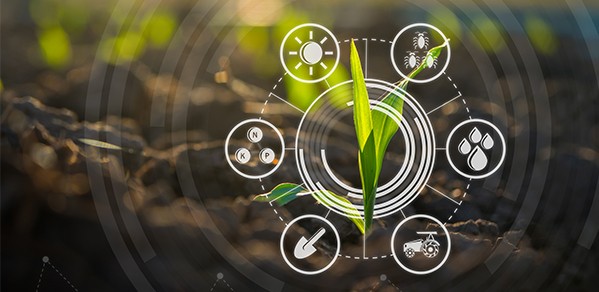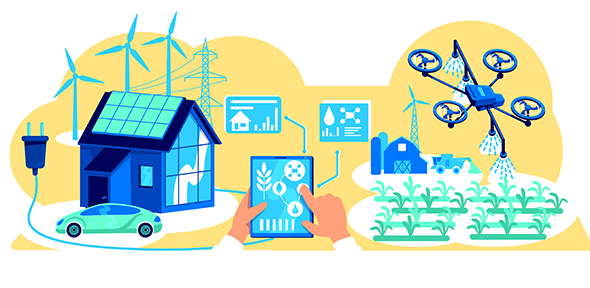
Combining Digital Twins with Artificial Intelligence (AI) decision-making technologies can transform agrifood production systems and supply chains – offering possible remedies to the problems of malnutrition, greenhouse gas (GHG) emissions, and food waste, say researchers.
Agrifood sector sustainability is an area that could really benefit from the live monitoring and comprehensive computational ecosystems that Digital Twins have to offer, enabling the simulation of crops and farms, for example.
Dr Catherine Richards
A review of the potential benefits of using Digital Twins (virtual replicas) alongside AI, smart sensors and other embedded systems, has found techno-economic limitations, as well as barriers to their deployment, which threaten the goal of building inclusive, productive, and sustainable agrifood systems. The findings are reported in the journal npj Science of Food.
Creating virtual representations of entire farming systems and combining them with advanced decision-making technologies can bring many benefits, say the researchers, at a time when agrifood production systems and supply chains are not currently on track to meet the Sustainable Development Goals (SDGs).1
Using reinforcement learning – a field of AI best suited to managing complex decision-making – Digital Twins can determine the best strategy when it comes to maximising crop yield, for example, in addition to offering predictions and ‘what-if’ simulations for testing and identifying pathways to improving agrifood sector sustainability.
The digitalisation of agricultural production shows promise for resource efficiency gains, like labour cost reductions, along with addressing animal health and biodiversity loss.
The study, authored by Dr Asaf Tzachor and Dr Catherine Richards, from the Centre for the Study of Existential Risk (CSER) at the University of Cambridge, in collaboration with PhD student Scott Jeen, from the Resource Efficiency Collective at Cambridge, identifies potential “transformative” applications of ‘virtual farms’ and agrifood value chains, from agriculture production through to food consumption. These focus on:
- Agrochemicals for agricultural production. The carbon footprint involved in the manufacture of these agrochemicals, such as nitrogen and phosphorous fertilisers, pesticides, and crop seeds, is significant. Agrochemicals are essential for yield productivity, but CO2 emissions are a problem during the manufacturing process.
Digital Twins could enable new ‘virtual crops’ to be rapidly stress-tested in computer laboratories under alternate conditions, including precipitation, temperature and salinity, to discover desirable traits or risk factors. Such laboratories could also prove useful in supporting seed improvements for climate resilient staples.
- Primary agricultural production. Digital Twins can replicate agricultural production conditions, including atmospheric factors, land form changes and soil microbiology, for example, thus supporting precision agriculture at unprecedented scales. Such Digital Twins are likely to use cameras and smart sensors for up-to-the-minute monitoring of crucial factors such as temperature, humidity, irrigation and nutrient supply.
Digital Twins can also offer rapid experimentation in ‘virtual farms’. Hydroponic farming, for instance, challenges traditional methods in favour of soil-less, water-based farming processes. In this scenario, Digital Twins can offer a virtual forecasting model to provide bespoke feedback to farmers that can cater to the farm’s changing operational conditions.
- Storage and transportation. Ventilation management is important when it comes to transporting produce by rail, road and sea, and also during periods of storage, for example cargos of grain are susceptible to mould, mustiness and early germination.
Digital Twins could be used to create real-time replicas of stationary elevators and vessels on a voyage, tracking ventilation periods and moisture content of cargo, as well as acting as an early warning system issuing alerts of contamination that warrant fumigation. Digital Twins can also be used to inform new delivery strategies that limit food waste.
- Food processing. Food loss and waste is prevalent in both developed and developing regions and has implications for food security and the environment.
Here, Digital Twins can help prevent food loss by being deployed in smart manufacturing plants to monitor ingredient delivery schedules, plant throughput, ingredient wastage, operator work schedules and demand forecasts. Reinforcement learning models can then be trained to ensure expected demand is met whilst minimising waste.
- Distribution and retail. Food distribution networks are significant contributors to global GHG emissions.
In a bid to minimise carbon emissions and food wastage, Digital Twins could be repurposed to mimic food distribution systems, and used to optimise delivery schedules, offering live temperature readings in order to track produce quality and predicting delays in supply chains (aided by reinforcement learning), for example.
- Food consumption. Malnutrition affects people in every country. The consequences of this may lead to anaemia and an increased risk of cardiovascular diseases, for example.
It is anticipated that Digital Twins could support nutrigenetics (the study of how our genes react to nutrients and the health implications of this), via Internet of Things (IoT) wearable devices, for example, whereby virtual representations of humans could be used to study the health effects of food choices, leading to customised dietary interventions and preventive healthcare, thereby reducing malnutrition.

Smart technology for farming concept. Credit: NTL studio – stock.adobe.com
“The potential of virtualised agrifood systems and supply chains is yet to be realised, especially with regards to curbing GHG emissions, food waste and malnutrition,” said Dr Richards, who completed her PhD at the Department of Engineering.
“Repurposing Digital Twins for more advanced applications is not a new idea. Although it has already taken off in the context of climate change and extreme weather, for example, the same cannot be said with regards to improving agrifood sector sustainability. This is an area that could really benefit from the live monitoring and comprehensive computational ecosystems that Digital Twins have to offer, enabling the simulation of crops, farms, agricultural equipment, storage facilities, processing factories, and distribution networks. However, Digital Twins do have their limitations, which need addressing, and considerable barriers exist, which are currently limiting the sizeable and meaningful implementation of Digital Twins across the global food sector.”
According to their review, there are four factors that threaten to derail future attempts to create ‘virtual farms’ and agrifood value chains. These are defined as:
- Digital Twin uncertainty. Even with sufficient sensor coverage, the Digital Twin can only ever be an approximation of the physical system. Therefore, its state representation and future predictions are uncertain.
- Technological error. In practice, sensors can fail. This means unsafe behaviour is likely if reinforcement learning agents are selecting control actions using a model with erroneous sensor data. It is also a barrier to scaled deployment.
- Human error. A small notational error in the code of a computation model used for predictive maintenance of an irrigation system, for instance, could affect sound decision making, leading to crop yield failures and resulting in losses.
- Compatibility difficulties. There is currently a question mark over the lack of common modelling standards for Digital Twins – so how can they be integrated separately and successfully?
The review also hints at a geographical divide that is creating a barrier to implementation of Digital Twins across the food sector globally. Lower-middle income economies are unable to make use of the technology due to the expertise, methods and infrastructure involved.
“Multidisciplinary collaborations involving computer science, agriculture, food and nutrition experts must be initiated,” said Dr Tzachor. “More focus is needed on deploying Digital Twins across the agrifood sector, building inclusivity and developing computer science literacy across the food sector globally, particularly in lower-middle income economies where there is the greatest need; malnutrition is widespread, agricultural productivity is low and food spoilage and waste are high. If the transformation of the agrifood sector with Digital Twins is to be realised successfully and at scale, then we need the technology in place to achieve this via investment in open access and standardised data sets, for example.”
Reference:
Asaf Tzachor, Catherine E. Richards, Scott Jeen. ‘Transforming agrifood production systems and supply chains with digital twins.’ npj Science of Food (2022). DOI: 10.1038/s41538-022-00162-2
- - -
1 The SDGs sit at the heart of a shared blueprint adopted in 2015 by all United Nations Member States and are an urgent call for action by all developed and developing countries as part of a global partnership.

